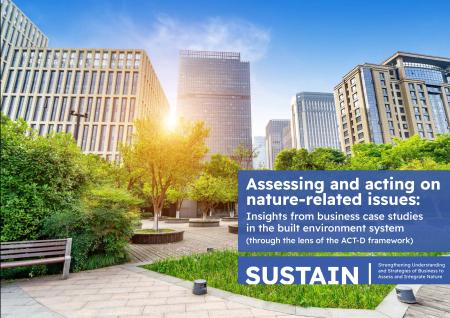
Resource description:
This document offers practical insights that build on existing resources, including the Roadmaps to Nature Positive: Foundations for all businesses and Taskforce on Nature-related Financial Disclosures (TNFD) LEAP (Locate, Evaluate, Assess, Prepare) approach. Its aim is to enhance understanding of how companies can strategically identify and manage nature-related issues. This is illustrated through real company examples.
This document presents case studies of businesses in the built environment system, which accompany similar documents focusing on energy and the agri-food. Each of these documents presents how companies are working to identify and assess nature- related issues in alignment with the High-level Business Actions on Nature to Assess, Commit, Transform and Disclose (ACT-D) framework.
While all four steps of ACT-D are addressed, the primary focus is on the initial step, Assess, emphasizing the importance for companies to systematically address relevant nature-related dependencies, impacts, risks and opportunities (DIROs). By doing so, a company is more likely to develop a credible strategy on nature, in line with the Now for Nature campaign, and be on the right path towards contributing to the Global Goal for Nature – to halt and reverse nature loss by 2030 on a 2020 baseline, and achieve full recovery by 2050.
This document on the built environment system presents three built environment company case studies showcasing their nature journey through the strategic steps of ACT-D framework: Sacyr, Holcim and AECOM. Each case study is different, as there is no ‘one-size-fits-all’ approach: the case studies are included to inform and inspire action in other companies. Given the evolving nature of sustainability practices, it is advisable to continuously review and update strategies in line with emerging industry standards, regulatory changes, and evolving best practices.
Who is this resource for?
Sustainability and nature teams within companies, civil society organizations working with the business community, financial institutions (investing in the focus sectors) can all use this document to deepen their understanding how to start identifying and assessing nature-related issues, and to apply further strategic steps. It provides an opportunity to learn about the challenges, risks, and opportunities experienced by peers.
Author/Contact:
Lead author: Amanda Griniece, WBCSD
Contributing authors: Nadine McCormick, WBCSD, Eve Gleeson, ShareAction